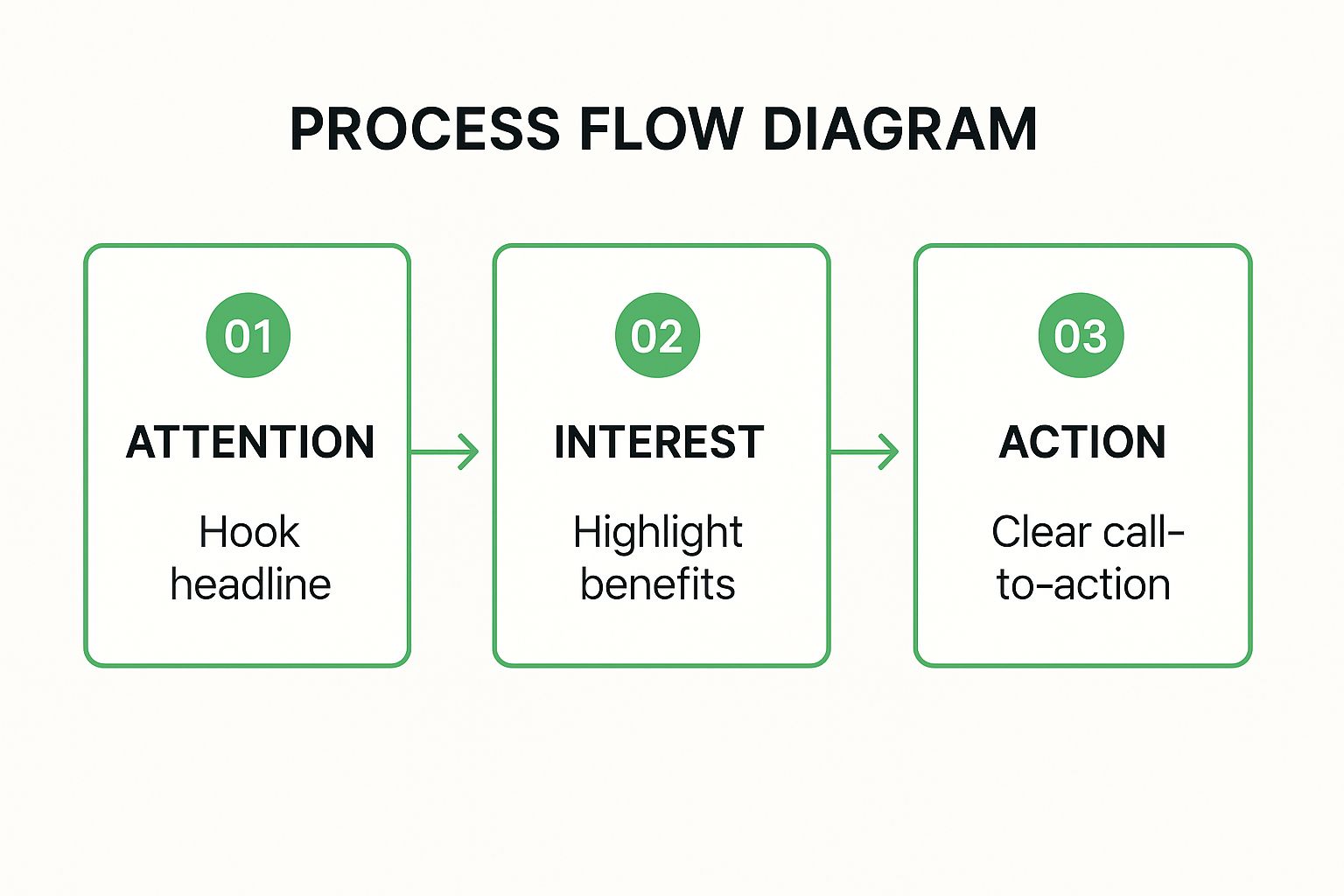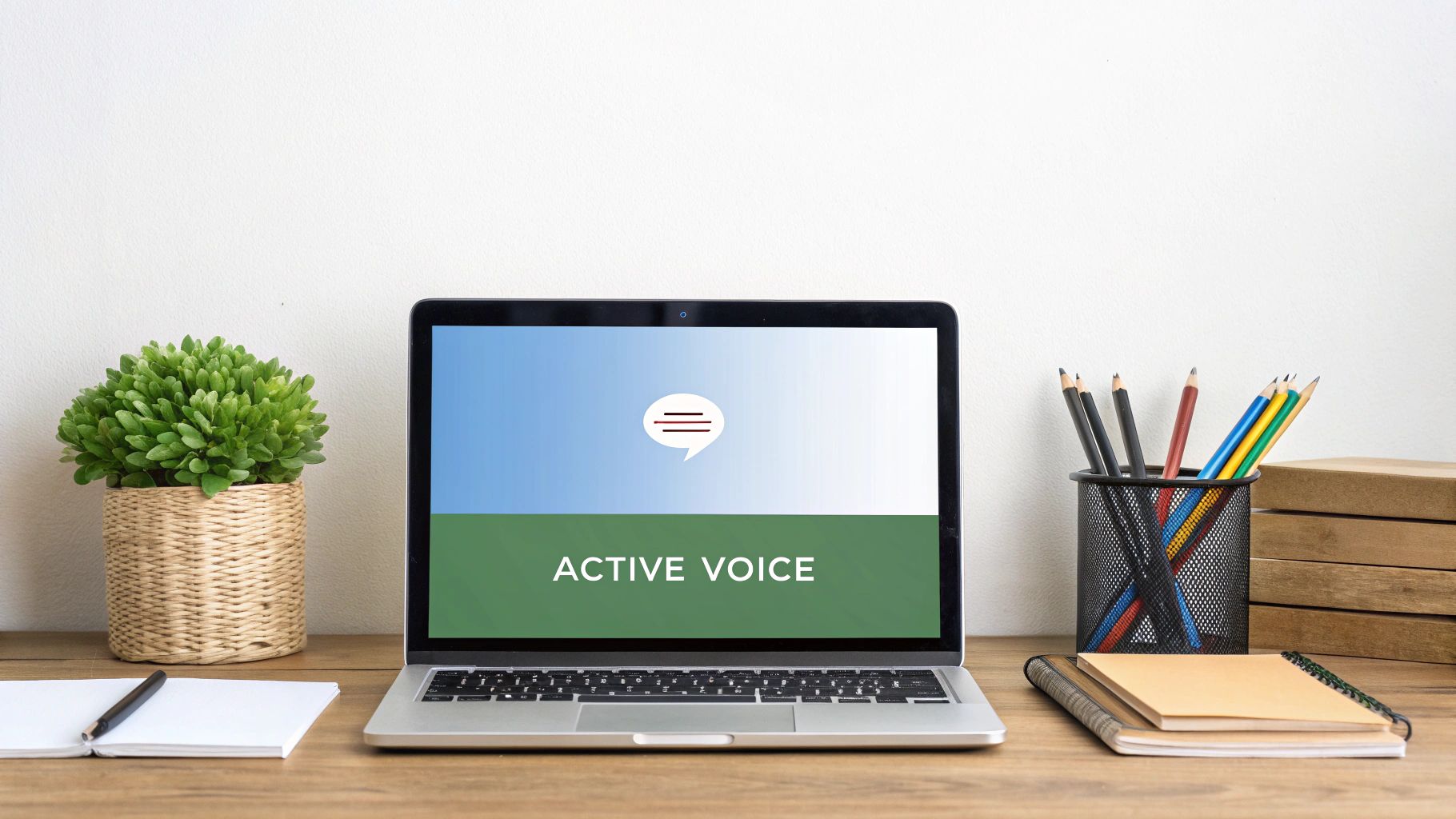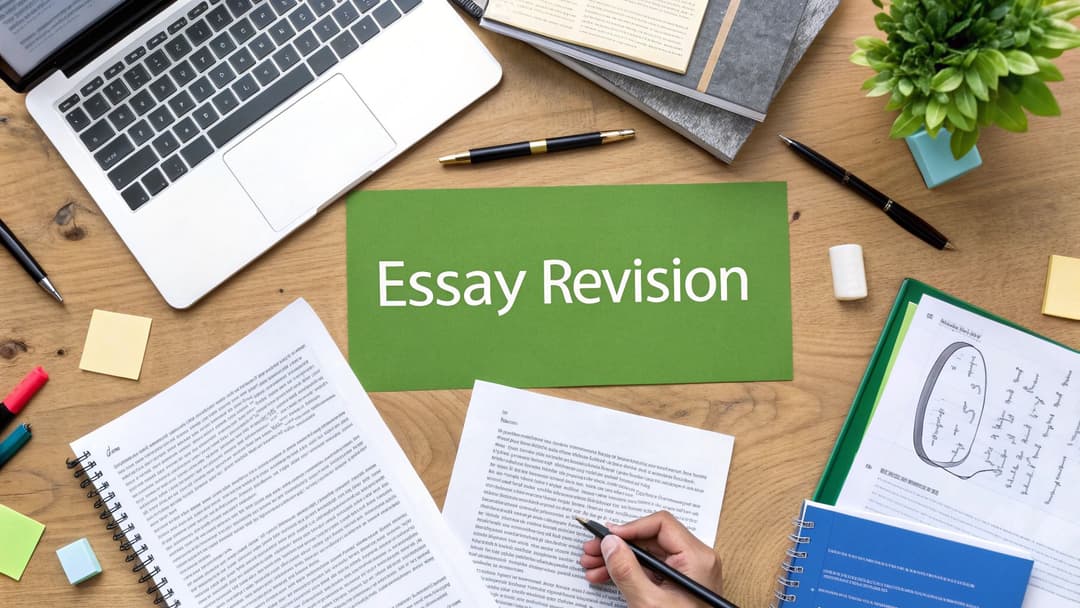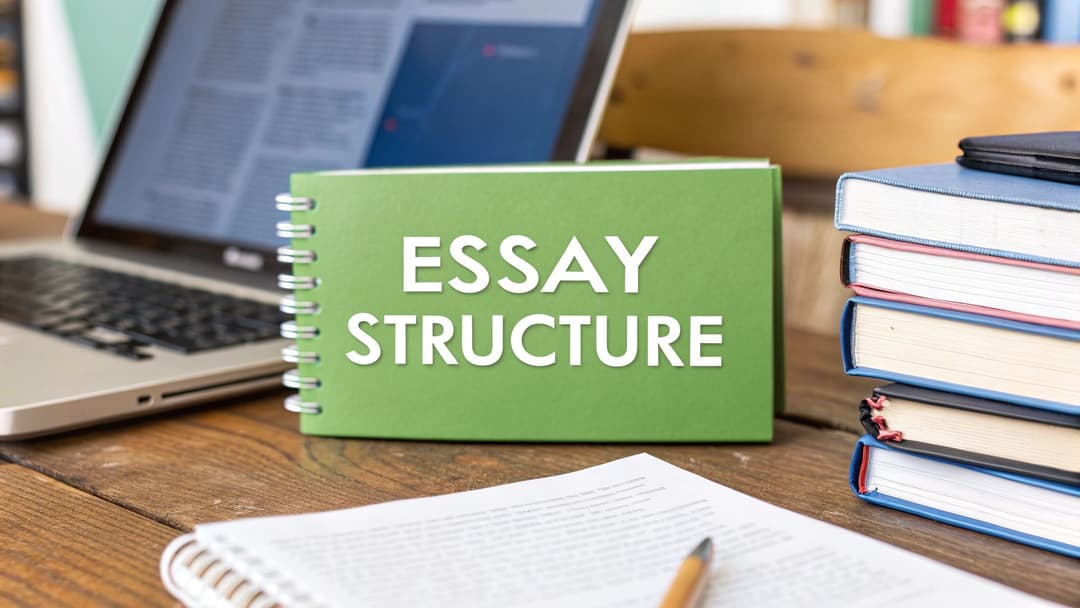
8 Effective Writing Strategies to Master in 2025
June 19, 2025
Effective Writing Strategies for Maximum Impact
Whether you're a student polishing a research paper, a marketer crafting a compelling campaign, or a blogger refining an article, the goal is the same: to communicate your message with clarity and power. Strong writing isn't an innate talent; it's a skill built upon a foundation of proven techniques. Moving beyond generic advice like "write more" or "know your audience," this guide focuses on specific, actionable frameworks you can implement immediately to transform your work. These methods provide the structure and psychological triggers needed to capture attention, hold interest, and persuade readers to act.
This article breaks down eight powerful and effective writing strategies that professionals use to achieve consistent results. We will explore practical frameworks such as the Inverted Pyramid for delivering crucial information upfront and the AIDA model for guiding readers through a decision-making process. You’ll learn how to apply storytelling principles to make your content more memorable and how to use active voice to make your sentences more dynamic. Each strategy is presented with clear implementation steps and real-world examples, providing a toolkit you can draw from for any writing project. Prepare to elevate your writing from simply good to truly effective.
1. The Inverted Pyramid Structure
Originating in the fast-paced world of journalism, the inverted pyramid is one of the most powerful and effective writing strategies for capturing and retaining reader attention. This technique flips the traditional storytelling structure on its head. Instead of building to a climax, you present the most critical information first, followed by supporting details in descending order of importance. This front-loading approach ensures your audience grasps the core message immediately, even if they only read the first few sentences.

The primary benefit is efficiency. In our information-saturated digital age, readers scan content looking for key takeaways. By placing the conclusion at the beginning, you respect their time and cater to modern reading habits. This structure is prevalent in news articles from sources like the BBC and The Associated Press, corporate press releases, and even public safety alerts, where conveying essential facts quickly is paramount.
How to Implement This Strategy
To effectively use the inverted pyramid, start by condensing your main point into a powerful headline and opening paragraph. This initial section should answer the "5 Ws and H": Who, What, When, Where, Why, and How.
- Most Important Information (The Lead): Your opening paragraph must stand alone, summarizing the entire story. Think of it as an executive summary.
- Important Details (The Body): Subsequent paragraphs should offer context, quotes, evidence, or supporting data. Each paragraph should be less critical than the one before it.
- General/Background Information (The Tail): The final section contains the least essential details, such as historical background or related but non-critical information.
By structuring your content this way, you create a piece that is easy to scan, simple to understand, and highly effective for any reader who might stop before the end. It's a foundational strategy for clear and impactful communication in almost any professional context.
2. Show, Don't Tell Technique
One of the most fundamental yet powerful effective writing strategies is the principle of "Show, Don't Tell." Popularized by literary giants like Anton Chekhov and Ernest Hemingway, this technique moves beyond simple statements, encouraging writers to immerse readers in a story through action, sensory details, and dialogue. Instead of telling the audience a character is sad, you show them with slumped shoulders, a quivering lip, and downcast eyes, allowing readers to arrive at that conclusion organically.

The primary benefit of this approach is reader engagement. Showing creates a vivid, cinematic experience that makes content more memorable and emotionally resonant. This is why Maya Angelou showed the brutal reality of racism through specific, personal incidents in I Know Why the Caged Bird Sings, rather than just describing it. The technique is equally potent in marketing, where Nike's campaigns show athletes in motion instead of just talking about motivation. It transforms passive reading into an active, interpretive experience.
How to Implement This Strategy
To master the "Show, Don't Tell" technique, focus on painting a picture with words that appeals to the reader's senses and intellect. Move from abstract claims to concrete evidence. For a deeper understanding, explore how to write compelling content with this method.
- Replace Adjectives with Actions: Instead of writing "He was angry," describe his actions: "He slammed the door so hard the picture frames on the wall rattled."
- Use Sensory Details: Engage sight, sound, smell, touch, and taste to ground the reader in the scene. Describe the smell of rain on hot asphalt or the feel of coarse sand underfoot.
- Leverage Revealing Dialogue: Let characters' personalities and relationships unfold through their conversations. What they say, and how they say it, should reveal their inner state without direct explanation.
- Focus on Specific Moments: Rather than saying "She had a difficult childhood," show a specific memory, like hiding under the stairs while her parents argued.
By using showing over telling, you empower your readers to become active participants in the narrative. This fosters a deeper connection to your message, making it a cornerstone strategy for impactful storytelling in any genre.
3. The AIDA Framework
A cornerstone of persuasive writing, the AIDA framework is a classic marketing and copywriting model that guides the reader through a specific psychological journey. This acronym stands for Attention, Interest, Desire, and Action. Developed by advertising pioneer E. St. Elmo Lewis in 1898, this model provides a reliable blueprint for structuring content to convert readers into customers, supporters, or followers. It’s one of the most effective writing strategies for any piece designed to persuade, from sales pages to fundraising letters.
This model's power lies in its structured approach to influencing behavior. Instead of simply presenting information, it creates a narrative path that captures a reader's focus, builds engagement, creates an emotional connection to a solution, and then provides a clear, compelling next step. Modern examples are everywhere, from the benefit-driven product descriptions on Amazon to the viral launch video for Dollar Shave Club, which masterfully grabs attention with humor, builds interest in its simple solution, creates desire for its convenience, and drives action with a clear signup button.
The infographic below illustrates the core process flow of the AIDA model, breaking down how to guide a reader from initial awareness to a final, decisive action.

This visualization highlights the essential sequence, where each stage logically follows the previous one to build momentum toward the desired outcome.
How to Implement This Strategy
To use the AIDA framework effectively, you must intentionally craft each section of your text to serve one of the four stages. Think of it as building a bridge for your reader, with each part leading them smoothly to the next.
- Attention: Start with a powerful hook. This could be a provocative question, a shocking statistic, or a bold headline that stops the reader from scrolling. Your only goal here is to grab their focus.
- Interest: Once you have their attention, you need to hold it. Use compelling storytelling, surprising facts, or relatable problems to build interest. This is where you make the reader think, "This is relevant to me."
- Desire: Shift from building interest in the topic to creating desire for your specific solution. Focus on the benefits, not just the features. Paint a picture of how the reader’s life will improve after they adopt your idea, product, or service.
- Action: Finally, tell the reader exactly what to do next. This is your Call-to-Action (CTA). It must be clear, direct, and easy to follow. Use strong command verbs like "Subscribe Now," "Download Your Free Guide," or "Join the Community."
By following this sequence, you create a persuasive argument that feels natural and compelling, dramatically increasing the chances that your reader will follow through on your intended action.
4. Active Voice Writing
One of the most powerful and effective writing strategies for creating clear, direct, and engaging content is the use of the active voice. This fundamental technique structures sentences so that the subject performs the action, rather than receiving it. Active voice writing is dynamic and authoritative, eliminating the wordiness and ambiguity that often accompany passive constructions. This approach makes your message more accountable and easier for readers to understand by forging a strong, immediate connection between the subject and the action.

The benefit of active voice is profound clarity and impact. Advocated by literary giants like George Orwell and codified in style guides like "The Elements of Style," it forces writers to be specific about who is doing what. This directness is invaluable in all forms of communication. For example, Nike's slogan "We design innovative products" is far more compelling than the passive "Innovative products are designed by us." Similarly, a news headline stating "Mayor announces new policy" is stronger and more immediate than "A new policy was announced." For those looking to learn more, exploring ways to improve writing can provide deeper insights.
How to Implement This Strategy
Adopting an active voice requires a conscious effort to prioritize the actor in your sentences. This simple shift can dramatically improve the readability and energy of your prose.
- Identify the Actor: Always start by asking who or what is performing the action in your sentence. Place that person or thing at the beginning.
- Use Strong Verbs: Swap weak verb phrases (e.g., "is making a decision") with strong, specific verbs (e.g., "decides"). This cuts down on unnecessary words.
- Spot Passive Indicators: Look for "by" phrases (e.g., "the report was written by the team") and forms of the verb "to be" (is, am, are, was, were) followed by a past participle, as these often signal passive voice.
- Rewrite for Clarity: Convert passive sentences into active ones. Instead of "The new feature was launched by the marketing team," write "The marketing team launched the new feature."
By consistently applying these steps, you will produce writing that is not only more engaging but also more transparent and professional. It's a cornerstone of effective writing strategies that ensures your message is delivered with confidence and precision.
5. Storytelling Arc Structure
Harnessing the power of narrative is one of the oldest and most effective writing strategies available. The storytelling arc is a classic framework that organizes information around a familiar journey: setup, rising action, climax, and resolution. This structure taps into our innate human connection to stories, making complex information more relatable, memorable, and persuasive by creating an emotional investment and guiding the reader through a satisfying progression from problem to solution.
This approach transforms dry facts into a compelling experience. Instead of simply presenting data, you frame it within a narrative that features a character (or customer, or company) facing a challenge and undergoing a transformation. This strategy is powerfully demonstrated in marketing, such as Dove's 'Real Beauty' campaign, which tells stories of women's journeys toward self-acceptance, and in influential TED Talks that often follow a speaker’s personal journey of discovery.
How to Implement This Strategy
To use the storytelling arc effectively, you must identify the core elements of your narrative and structure them logically. The goal is to create a journey that resonates with your audience, making your message stick long after they’ve finished reading.
- Establish the Setup: Begin by introducing a relatable character or situation. This is where you establish the “before” state and create a connection with the reader. It should set the scene and present the initial context.
- Introduce the Conflict: Early on, present a clear challenge, problem, or question that the character must overcome. This conflict creates tension and gives the audience a reason to stay engaged. It is the central engine of your story.
- Show the Journey (Rising Action): Detail the steps, struggles, and efforts made to address the conflict. This is where you can weave in supporting data, evidence, and key insights. Show the process, not just the final result, to build credibility and emotional depth.
- Deliver the Resolution: Conclude with the outcome or solution. This should directly address the initial conflict and demonstrate a clear transformation or lesson learned. End with a powerful takeaway that reinforces your core message.
By structuring your content as a story, you make it inherently more engaging and persuasive, a vital technique for case studies, brand histories, and any writing that aims to influence.
6. Parallel Structure (Parallelism)
Parallel structure, or parallelism, is a sophisticated writing technique that uses consistent grammatical patterns to create rhythm, emphasis, and clarity. This strategy enhances readability by establishing a sense of balance and flow, making your sentences more memorable and persuasive. Instead of presenting ideas in mismatched formats, you align them in a series, creating a smooth and intellectually satisfying experience for the reader. This is one of the most effective writing strategies for making complex ideas digestible and elegant.
The power of parallelism lies in its psychological impact. The human brain is wired to recognize patterns, and a parallel structure provides a predictable and pleasing rhythm. This makes the content easier to process and retain. Its influence is evident in some of history's most powerful speeches, such as Martin Luther King Jr.'s repetition of "I have a dream," and in iconic advertising, like Julius Caesar's legendary "Veni, vidi, vici" (I came, I saw, I conquered). This structure turns simple statements into powerful, resonant messages.
How to Implement This Strategy
To use parallelism effectively, you must ensure that words, phrases, or clauses in a series share the same grammatical form. This consistency is key to achieving its desired effect. Pay close attention to your sentence construction, especially when creating lists or making comparisons.
- Maintain Grammatical Consistency: Ensure all items in a series are in the same form. For example, if you start with an "-ing" verb, continue with "-ing" verbs (e.g., "She loves running, swimming, and hiking," not "She loves running, to swim, and to go on a hike").
- Apply to Lists and Headings: Parallelism is incredibly effective for bullet points and headings. It makes them scannable and professional. For instance, ensure all your section headings start with a verb or a noun for consistency.
- Check for Rhythm by Reading Aloud: The best way to test for parallelism is to read your writing out loud. Your ear will quickly catch awkward or unbalanced phrasing that breaks the rhythmic flow. If a sentence sounds clunky, it likely has a parallelism error.
By mastering this strategy, you can elevate your writing from merely functional to truly impactful. It’s a foundational technique for anyone looking to write with clarity, elegance, and persuasive power in professional, academic, or creative contexts.
7. The Problem-Agitation-Solution (PAS) Method
A staple in the world of persuasive copywriting and marketing, the Problem-Agitation-Solution (PAS) method is one of the most compelling effective writing strategies for driving action. This psychological framework hooks readers by tapping into their core needs and pain points. It starts by identifying a problem your audience faces, intensifies the emotional impact of that problem by exploring its negative consequences, and then offers your product, service, or idea as the ideal solution.
This strategy is highly effective because it builds a strong emotional connection and creates a sense of urgency. By first making the reader acutely aware of their discomfort, the subsequent solution feels more like a necessary relief than a simple pitch. It’s used powerfully by cybersecurity firms describing the devastating fallout of a data breach before presenting their protection software, or by financial advisors detailing the anxieties of a retirement shortfall before introducing an investment plan.
How to Implement This Strategy
To use the PAS framework effectively, you must have a deep understanding of your audience’s genuine challenges. This allows you to move beyond generic statements and create a narrative that resonates on a personal level.
- Problem (P): Start by clearly stating a specific problem your reader is experiencing. Use direct, relatable language to show you understand their situation. For example, "Staring at a blank page, paralyzed by writer's block?"
- Agitation (A): This is where you amplify the pain. Describe the frustrations, consequences, and emotional toll of the problem. Dig into the details. For instance, "Deadlines loom, opportunities are missed, and that brilliant idea in your head starts to fade, replaced by mounting anxiety."
- Solution (S): Present your solution as the direct and perfect answer to the agitated problem. Explain exactly how it resolves the pain points you just highlighted. "Our AI writing assistant provides targeted prompts and sentence starters to break through the block instantly, turning your ideas into polished drafts."
By following this structure, you guide the reader on an emotional journey that logically concludes with them embracing your proposed solution. It's a foundational technique for anyone writing to persuade, from marketers and sales professionals to advocates and thought leaders.
8. Concise and Clear Communication
In an era of information overload, the ability to communicate directly and efficiently is more valuable than ever. Concise and clear communication is an effective writing strategy centered on one core principle: every word must serve a purpose. Popularized by masters of prose like William Strunk Jr., E.B. White, and George Orwell, this approach involves stripping away jargon, eliminating filler words, and simplifying complex ideas. The goal is to make your message as easy as possible for the reader to understand and act upon, respecting their limited time and attention.
This strategy is not about dumbing down content; it's about maximizing impact through precision. By prioritizing clarity over complexity, you ensure your core message is absorbed instantly. This is why companies like Apple use minimalist product descriptions that focus on tangible benefits, and why emergency instructions rely on simple, direct commands. It’s a powerful technique that builds trust and authority by demonstrating a clear command of the subject matter. To explore this topic further, you can find a wealth of information in our professional writing tips.
How to Implement This Strategy
Adopting a concise and clear style requires a disciplined editing process. Your first draft can be expansive, but your final version should be lean and potent. Focus on making your sentences direct and your language accessible.
- Eliminate Redundancy: Actively hunt for unnecessary words. Replace phrases like "due to the fact that" with "because" and "in order to" with "to." Use tools like the Hemingway Editor to highlight overly complex sentences and adverbs that can be cut.
- Use Simple, Precise Language: Swap jargon, corporate-speak, and academic language for everyday words that a broader audience can understand. Instead of "leverage synergies," say "work together."
- Structure for Readability: Break down complex information using bullet points and short paragraphs. This makes the content scannable and easier to digest.
- Read It Aloud: This is one of the most effective ways to catch awkward phrasing and confusing sentences. If it’s hard to say, it will be hard to read.
By making conciseness a cornerstone of your writing, you create content that is not only easier to read but also more persuasive and memorable. This is a fundamental skill for anyone looking to master effective writing strategies.
Effective Writing Strategies Comparison
| Writing Technique | Implementation Complexity 🔄 | Resource Requirements ⚡ | Expected Outcomes 📊 | Ideal Use Cases 💡 | Key Advantages ⭐ |
|---|---|---|---|---|---|
| The Inverted Pyramid Structure | Low 🔄 | Low ⚡ | Immediate key information delivery 📊 | News articles, press releases, newsletters, landing pages, executive summaries 💡 | Captures attention quickly, scannable content ⭐ |
| Show, Don't Tell Technique | High 🔄 | High ⚡ | Engaging, immersive storytelling 📊 | Creative writing, brand storytelling, case studies, personal narratives, marketing copy 💡 | Builds emotional connection, memorable content ⭐ |
| The AIDA Framework | Moderate 🔄 | Moderate ⚡ | Persuasive progression to action 📊 | Sales letters, email marketing, landing pages, ads, product descriptions 💡 | Clear structure for persuasion, proven sales effectiveness ⭐ |
| Active Voice Writing | Low 🔄 | Low ⚡ | Clear, dynamic, concise writing 📊 | Business communication, academic writing, news reporting, technical docs, web copy 💡 | Increases clarity, stronger engagement ⭐ |
| Storytelling Arc Structure | High 🔄 | Moderate ⚡ | Emotional engagement, memorable narratives 📊 | Brand marketing, case studies, presentations, content marketing, fundraising 💡 | Facilitates retention and sharing, emotional impact ⭐ |
| Parallel Structure (Parallelism) | Moderate 🔄 | Low ⚡ | Rhythm, emphasis, memorability 📊 | Speeches, marketing copy, mission statements, product lists, motivational content 💡 | Enhances readability and impact, professional tone ⭐ |
| The Problem-Agitation-Solution (PAS) Method | Moderate 🔄 | Moderate ⚡ | Emotional urgency, motivated action 📊 | Sales pages, email sequences, webinars, service marketing, B2B selling 💡 | Strong emotional appeal, clear value proposition ⭐ |
| Concise and Clear Communication | Low 🔄 | Low ⚡ | Efficient, clear understanding 📊 | Technical docs, business communication, UI copy, instructions, executive summaries 💡 | Improves comprehension and retention, professional tone ⭐ |
Mastering the Craft: Your Path to Powerful Writing
We've journeyed through a powerful arsenal of effective writing strategies, each a distinct tool for crafting clearer, more persuasive, and deeply resonant content. From the journalistic precision of the Inverted Pyramid to the persuasive pull of the AIDA and PAS frameworks, you now have a versatile toolkit to tackle any writing challenge. These aren't just abstract theories; they are the architectural blueprints used by the most successful writers, marketers, and academics to build messages that stand out and deliver results.
The true power of these techniques lies in their combined application. Imagine using the Storytelling Arc to structure a case study, employing the Show, Don't Tell technique to paint a vivid picture of the client's problem, and sharpening every sentence with the disciplined use of Active Voice and Parallelism. This multi-layered approach transforms good writing into unforgettable communication. The key is moving from understanding these concepts to actively implementing them in your daily work.
Your Action Plan for Effective Writing
Mastery doesn't happen overnight. It's built through consistent, intentional practice. To start integrating these effective writing strategies into your workflow, consider these next steps:
- Choose One Strategy: Don't try to implement all eight strategies at once. For the next week, focus on just one. If you tend to write passively, make a conscious effort to convert every sentence to the Active Voice. Pin a reminder to your monitor. The focused effort will help build a lasting habit.
- Analyze and Deconstruct: Take a piece of writing you admire, whether it's a compelling sales page, an engaging blog post, or a persuasive academic paper. Break it down. Can you identify the Problem-Agitation-Solution formula? Do you see the elegance of its Parallel Structure? Reverse-engineering great work is one of the fastest ways to learn.
- Embrace the Revision Process: Your first draft is for getting ideas down; revision is where the magic happens. Use a second pass specifically to check for clarity and conciseness. A third pass could be dedicated to strengthening your verbs and ensuring you are showing, not just telling.
Ultimately, becoming a more effective writer is about building a bridge between your ideas and your reader's mind. The stronger and clearer that bridge, the more impact your message will have. Whether you're aiming to boost conversions, earn higher grades, or simply share your story with the world, these strategies provide the foundation for success. The journey of a writer is one of continuous improvement, and with these tools in hand, you are well-equipped to make every word count.
To accelerate your progress and refine your drafts with greater efficiency, consider integrating a powerful writing assistant into your process. Natural Write helps you apply many of these effective writing strategies, from enhancing clarity to rephrasing for active voice, ensuring your final piece is polished and impactful. Explore how Natural Write can become an essential part of your writing toolkit today.


